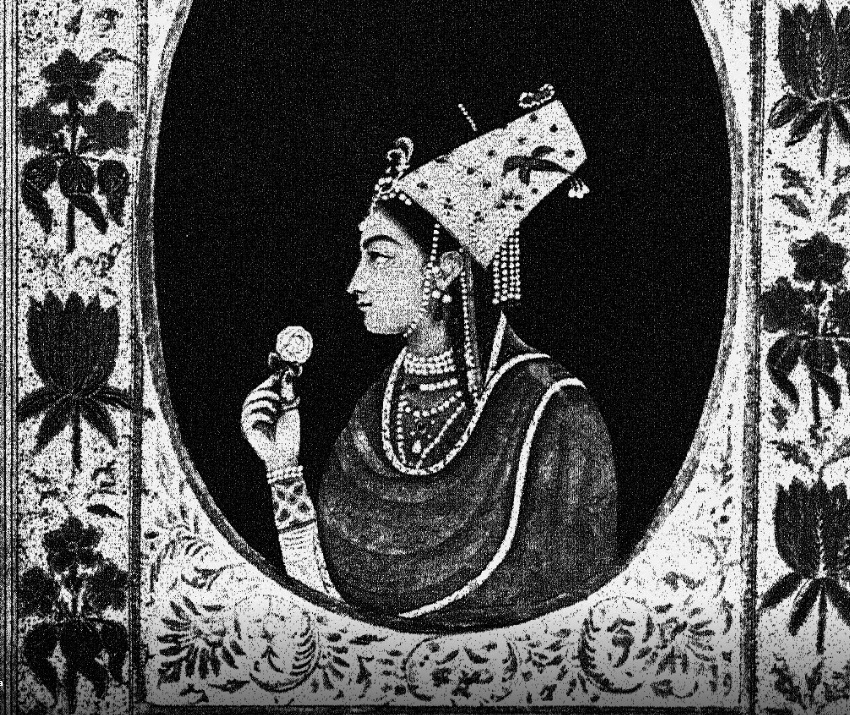Reign of the paramount Shahzadi Jahanara

She rules. She governs. She plays fair. She builds intricate buildings and is a patron of arts and poetry. She owns a ship which travels to Mecca & Madina for worship. She looks after the port of Gujarat. A grand procession takes place when she enters the Chandni Chowk. There are slow moving elephants, and men sprinkle water and flowers as she passes by. A woman stands in front of the elephant with an incense holder in her hand, shouting at every step, "Bismillah! Here comes her highness, Shahzadi Jahanara Begum! Bismillah!"
It is the season of Spring day in Shahjahanabad in the year of 1654 and the crowds are as impatient to see the Shahzadi. She is forty years old, unmarried and at the peak of her glory. Known to the common public as Begum Sahib. With my personal great interest, I happily introduce you today to one of the most influential women in the Mughal household. A Timurid woman by birth, she had a very important role in her father's life. Jahanara was born in Ajmer in the year 1614 to the then reigning Padshah Shah Jahan and his Begum Mumtaz Mahal. A few accounts in my research say that he was Shah Jahan's favourite daughter.

Jahanara was not only a powerful administrator, but also a writer, a poet, and a writer. Her first book, Howal Moin is in Persian which is a collection of discourses of Khwaja Serai Moinuddin Chisti and his disciples. The Urdu translation of this book is popularly known as Munis al Arwah. Jahanara also proclaimed her utmost love for Sufi literature as being second to religion and confessed to reading and writing about the Sufi saints in an effort to get closer to them in spirit. She visited the Khwaja Serai's grave in Ajmer before writing the book. She wrote her second book Sahibia or Risalah - i - Sahibiya, which is a biography of her Murshid (spiritual guide) Mulla Shah Badakhshi. A learned scholar herself, she gave no consideration to royal hierarchy when it came to the spiritual realm.
She is best known for her architectural work of the grand caravanserai (roadside inn), sponsored the construction of Jami Masjid in Agra and the popular Chandni Chowk in Delhi. Herbert Charles Fanshawe, a British civil secretary in his accounts writes about the serai:
"Proceeding up the Chandni Chowk and passing many shops of the principal dealers in jewels, embroideries, and other products of Delhi handicrafts, the Northbrook Clock Tower and the principal entrance to the Queen's Gardens are reached. The former is situated at the site of the Caravanserai of the Princess Jahanara Begum known by the title of Shah Begum. The Serai, the square in front of which projected across the street, was considered by Bernier one of the finest buildings in Delhi, and was compared by him with the Palais Royal, because of its arcades below and rooms with a gallery in front above."

Chandni Chowk was commissioned by her in the heart of Shahjahanabad, present day old Delhi, meaning 'moonlit intersection'. Italian doctor, writer and traveler Niccolao Manucci fondly writes in his accounts about how she spent her nights in the company of her parents painting, writing poems and helping her father plan reconstructions of other palaces and monuments. She was known to her close family simply as 'Janni'. She also named herself as 'Faqirah’, which means a female sufi. She owned numerous gardens including Bagh-i-Jahanara, Bagh-i-Nur, Bagh-i-Safa and also was given the Jagir of villages like Farjhara, Achchol, 2 sarkars of Doharah, Safapur and Bachchol. The Shahzadi spent her days with everyone in the harem - lowest of concubines to her step mothers. She had a good relationship with her brother Dara Shikoh who shared their equal love for arts.
Jahanara and her family visited numerous places in India. There was a beautiful palace at Srinagar in Kashmir, where the harem often went for picnics on Silver Island on Dal Lake. While attending a garden party in 1644, her heavily perfumed kameez and pairhan robes caught fire. When she fell sick, Shah Jahan took care of her, nursed her back to safe health. She was cured by a mendicant (beggar) named Hanum. Jahanara composed many poems, painted and honoured her parents' love for arts. The biographical account of Zia-ud-din Ahmed Berni is one of the most detailed and definitive accounts of Jahanara. He describes the difficult period she went through after her mother Mumtaz Mahal's death after giving birth to the fourteenth child.
After Mumtaz Mahal's death, Shah Jahan was very keen on building the Taj Mahal but also became mentally weak. Seeing this opportunity, his son Aurangzeb seized the throne and declared himself as the new Mughal Padshah of Hindustan. Under Aurangzeb's orders, she was allowed certain licenses and also became the Padishah Begum (Princess of Princesses). Due to this title, she had the power to disobey and criticize the padshah's laws. She was also able to wear clothes which other women were no longer allowed to - Kameez. She embraced Hindus and Christians same way her brother Dara Shikoh had.
Ira Mukhoty in her book Daughters of the Sun has nothing but praises for Jahanara. She says "Jahanara establishes herself in the city as the most influential woman patron of literature and poetry. She collects rare and beautiful books, her library is peerless. She also had full access to emperor Akbar's library. Shahzadi donates money to charity, especially to the Sufi dargahs, carries gented diplomacy with the minor rajas who come with grievances and gifts."

French traveller Francois Bernier writes in his accounts, “Shah Jahan reposed unbounded confidence in his favorite child, she watches over his safety and so cautiously observant, that no dish was permitted to appear upon the royal table which had not been prepared under her supervision.” Manucci further also mentions in his accounts that Jahanara was loved by all, and lived in a state of magnificence.
Unlike other royal princesses, she also had a special honour of living in her own palace outside Agra fort. She had several important titles including Sahibat al-Zamani (Lady of the Age), Padishah Begum (Lady Emperor) or Begum Sahib (Princess of Princesses).
Jahanara spent her last years in the company of her artistic and humanitarian passions and passed away in 1681 at the age of 67. Her mausoleum lies at the Nizamuddin Auliya Dargah complex in New Delhi. It's purely made from white marble and has delicate carvings with no roof. The Sher inscribed on the tablet of the grave is her own creation in faarsi:
“Baghair sabza na-poshad kasey mazaar mura Ke qabr-posh ghareebaan hamin gayah bas-ast”
“Let no man cover my grave, except with green grass, For this very grass suffices as a tomb cover for the poor, The mortal simplistic princess Jahanara, Disciple of the Khwaja Moinuddin Chisti, Daughter of Shah Jahan, the conqueror, May Allah illuminate his proof Allah is the Living, the Sustaining”
Jahanara became a ray of hope for her father, for his beloved daughter who took care of him when his own son Aurangzeb imprisoned him at Agra fort. When we speak of 17th century India, dominated by a rigid power in nature, we instantly think of the limited freedom and rare independence these women had. But, these women, especially Jahanara whose ship Sahiba rode in the dangerous waters until Mecca and Madina for pilgrimage. She sets a quintessential example for the English women who had rarely had a chance to have their own money and use it at their own liberty. Whereas, Jahanara's revenue was in millions and she was in complete freedom to use it in her own space.

She was bold, fearless, and stood confident amongst her contemporaries, tried to make peace and was also a huge patron of arts and literature. She remained unmarried as the royal women were forbidden to be married, but she was promised by Dara Shikoh, her beloved brother that once he sits on the throne, he'd remove this rule and get her married to anyone of her choice. But, alas! Dara could never become the emperor and Jahanara devoted herself to sufism. She was generous, kind and golden. She continues to be a relevant figure and inspires generations of all kinds. Her legacy continues, everytime history is discussed, or her work is being spoken about. Truly, a myriad of how a Mughal Shahzadi would be. This write-up is dedicated to you, my beloved Shahzadi, my Jahanara!
Sanika Devdikar
workwithsanika@gmail.com
Bibliography :
Rekhta Foundation: Munis ul-Arwah
Sahibia - Translated to English by Sardar Ali Ahmad Khan
Wikimedia Commons
Daughters of the Sun - Ira Mukhoty
Jahanara - Lyane Guillaume
The Heritage Lab
